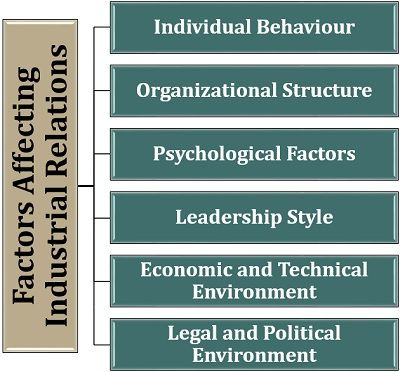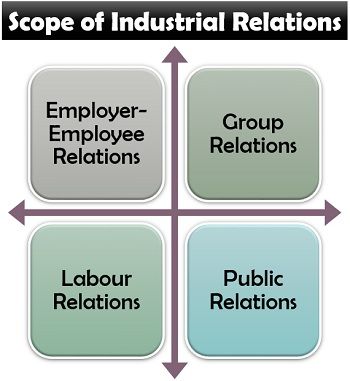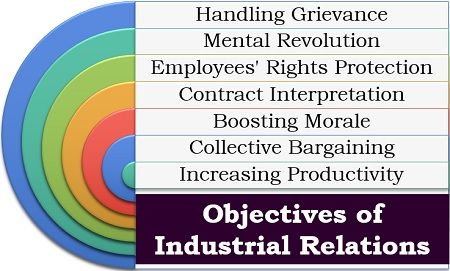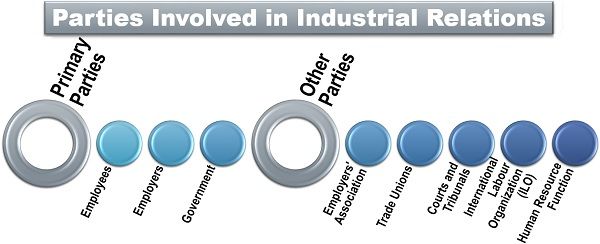Definition: Industrial relations is that field of study which analyzes the relationship among the management and the employees of an organization at the workplace and also provides a mechanism to settle down the various industrial disputes. This concept evolved in the late 19th century because of the industrial revolutions.
It is made up of the following two terms:
‘Industry‘ can be viewed as an economic activity (i.e., manufacturing, producing or processing of goods or services) which is performed by a group of individuals.
‘Relations‘ here refers to the connection and communication which pertains between the employer and the employees within a workplace.
Content: Industrial Relations
Factors Affecting Industrial Relations
Industrial relations deals with human behaviour and management of personnel in an organizational setup. The various factors that influence the relationship between the administration and the employees in an organization are as follows:

Individual Behavior
Every person has a different perception, background, skills, knowledge, experience and achievements which influences an individual’s behaviour. The employees, therefore, behave differently in different situations, thus impacting the work environment in the organization.
Organizational Structure
The hierarchical structure creates more formal relationships among the employees belonging to different hierarchical levels in an organization. Also, the delegation and execution of decision-making power by the superior influences the industrial relations between the managers and the employees.
Psychological Factors
An employee’s attitude and mentality towards the employer and the given task; and the employer’s psychology towards the workers can be positive or negative, which ultimately impacts the employee-employer relationship.
Leadership Style
Every manager possesses certain leadership traits and different style to function even in a formal organization. Through his/her formal or informal ways of generating team spirit and motivating the employees, he/she impacts the organization’s industrial relations.
Economic and Technical Environment
To cope up with the changes in the economic conditions or technology, organizations need to restructure the task of the employees including their work duration, conditions and wages; which leads to a difference in their behaviour, attitude, adapting spirit, etc. towards the organization and its people.
Legal and Political Environment
The legal framework and political circumstances influence the organization and its industrial relations. It contributes to the framing of rules, rights, authority, powers, roles and responsibilities of all the parties of the organization.
Parties Involved in Industrial Relations
To understand the concept of industrial relations, we should know that; who all are responsible for developing cordial relationships in the organization?
The different persons holding distinct positions in the organization and the external or internal associations involved in the process of building strong industrial relations can be bifurcated into the following two categories:
Primary Parties
Those persons or associations which are directly associated with or influenced by the functions of industrial relations are as follows:
Employees
The workers who provide their services to the organization are an essential resource and contributes to generating the desired output.
Following are some of the reasons for which employees find maintaining sound industrial relations to be useful for them:
- Sharing their views, suggestions and ideas with the management to improve the business operations;
- becoming a part of organizational decision-making and ensuring the betterment of the working conditions;
- speaking out their problems and grievances and seeking for the redressal of the same.
Employers
Employers are responsible for providing a favourable work environment for the employees. They have many rights and powers like laying off inefficient employees, taking strategic decisions such as mergers, acquisition or shutdown of the organization and adapting technological changes in the operations.
Following are the different ways in which managers can benefit from sound industrial relations in the organization:
- Motivating the employees to give their best and gaining their trust and commitment;
- improving the overall efficiency and ensuring effective communication among the employees and the management;
- dealing with problems of trade union along with negotiation of employment terms and conditions with such employee representative.
Government
Before the 19th century, the government didn’t use to intervene in the conflicts between the employer and the employee. However, later on, there was a change in the attitude of the government bodies, they started regulating the industrial relations through labour courts and tribunals, for the following reasons:
- Safeguarding the interest of both the parties;
- ensuring that both the employer and the employee, abide by the legal terms and conditions.
Other Parties
The parties (especially the internal or external bodies or associations) which impact the industrial relations within an organization are as follows:
Employers’ Association
It is an authoritative body, formed to protect the interest of the industrial owners. It performs the following functions to safeguard the rights of the employers:
- Representing the owners in collective bargaining with the employees or government and also in case of national issues;
- creating a proper mechanism to resolve industrial disputes;
- giving an insight into the employee relations in an organization and providing suggestions accordingly.
Trade Unions
When the workers unite together to form an association and elect a representative among themselves; for the protection of their rights and to raise their demands in front of the management; it is named as a trade union. Listed below are the objectives of such associations:
- Negotiating collectively with the administration for meeting the individual interest of an employee;
- upgrading the status of the employees in the organization;
- demanding better working conditions and higher job security for the workers;
- safeguarding the interest of the employees by demanding a higher level of democratic control over the decision-making at the organizational, corporate and national levels.
Courts and Tribunals
The judiciary includes the ‘courts’ to resolve the legitimate conflicts and the ‘judicial review’ to administer the justice of the constitution. These courts and tribunals play an essential role in settlement of industrial disputes by eliminating the possibilities of the following:
- Judicial flaws;
- conflicting judgment;
- poor evaluation of penalty;
- confusing terms and conditions.
International Labor Organization (ILO)
On the international grounds, an association was formed under the name of International Labor Organization in the year 1919 to set up international norms and standards for dealing with industrial disputes and issues of the workers.
Simultaneously, an International Labor Code (ILC) was set up to establish the recommendations and conventions for minimum international labour standards.
The ILC aimed to look into matters like:
- Worker’s compensation, i.e., minimum wages;
- employee’s work duration and number of holidays;
- women employment;
- employee’s safety, security and health in the work environment;
- industrial relations;
- medical facilities and examination along with maternity protection.
Human Resource Function
The human resource department or team acts as a mediator between the organization and its employees for dealing with the personnel issues and conflicts. It is their responsibility to ensure the maintenance of harmonious industrial relations in the company.
Following are the various other functions of the HR professional in the organization:
- Addressing the disputes at the initial level;
- acting as a change agent by bringing a mental revolution in case of any conflict between the workers and the management;
- performing the role of an administration expert and a strategic partner by ensuring the implementation of the policy decisions taken at the top level.
Scope of Industrial Relations
When we talk about industrial relations, it covers a vast arena, including all kinds of formal relationships existing in an organization.
The scope of industrial relations can be briefly classified into the following four dimensions:

Employer-Employee Relations
The relationship that pertains between the business owner and the employees of a particular company is known as the employer-employee relationship. To maintain sound relations, the employer must treat the employees fairly and should value their efforts.
Also adopting the various human resource strategies like employee relations program, performance-based promotions and even making the productive employees the stakeholders of the company.
Group Relations
The interactions and communication between the workers belonging to different workgroups are studied under group relations.
Labour Relations
In an organization, the relationship shared by the managers and the workers is termed as labour relations. It includes their behaviour, thoughts, actions and perception against each other.
It is also termed as community relations. The interaction and relationship of the organization (i.e., its owner, management and employees) with the society or external bodies is termed as public relations. For long-term existence in the business, every organization needs to maintain cordial public ties.
Objectives of Industrial Relations
Industrial relations hold a high significance in the context of human resource management about addressing the industrial disputes in an organization.
The various other goals of carrying out such practices are as follows:

- Handling Grievance: Industrial relations aim to maintain cordial relationship between the management and the employees by resolving the disputes and setting up a mechanism to address the grievances of both the parties.
- Mental Revolution: It emphasizes on transforming the way of thinking of both the management and the workers. The employer must value the worker’s contribution towards the organization, and at the same time, the employees must respect the authority of the management.
- Employees’ Rights Protection: Under industrial relations, various acts (like in India National Labor Relations Act) and associations were formed to safeguard the rights and interests of the employees (irrespective of their membership of the labour union).
- Contract Interpretation: Industrial relations emphasizes on providing proper training to the supervisors and the managers on the labour law contracts to clarify any misunderstanding.
- Boosting Morale: The motivated workforce is the most efficient resource of the organization. Therefore, industrial relations emphasizes on building employee’s confidence and boosting their morale to perform better than before.
- Collective Bargaining: The worker’s representative and the management put up their proposals in front of each other and negotiates over the same. This is to reach a mutual decision which is written down in a collective bargaining agreement.
- Increasing Productivity: Industrial relations aims at improving the efficiency and productivity of the organization by ensuring employees’ long-term retention and minimizing the rate of their absenteeism.
Role of Industrial Relations
Before the industrial revolutions, organizations paid very less attention to the workers’ relationship with the management and with each other. They treated the labour as machines and concentrated on their production capability and efficiency.
Later, in the year 1920, John R. Commons introduced the concept of industrial relations, which emphasized the impact of labour relations with the management and the employer on the productivity of the organization.
In the modern-day business world where the companies are becoming more people-oriented and work continuously for achieving employee satisfaction and retention, the study of industrial relations plays a significant role in the organizations.

Kwena says
This information is highly fruitful for me hence I would like to have more of it. It enhanced my knowledge hence will use it at all times where necessary.
Warm Regards
Kwena
Hema says
The material is very useful and not used any jargon language.
Nassif Mensah says
Very powerful………full of knowledge
Nazia Khan says
Very helpful for me
Abhishek Lamba says
Very helpful for me, thanx for such information about how relationships work in an organization. Thank you once again.
Shahida khatoon says
This article is very use full for us thanks such a informative knowledge